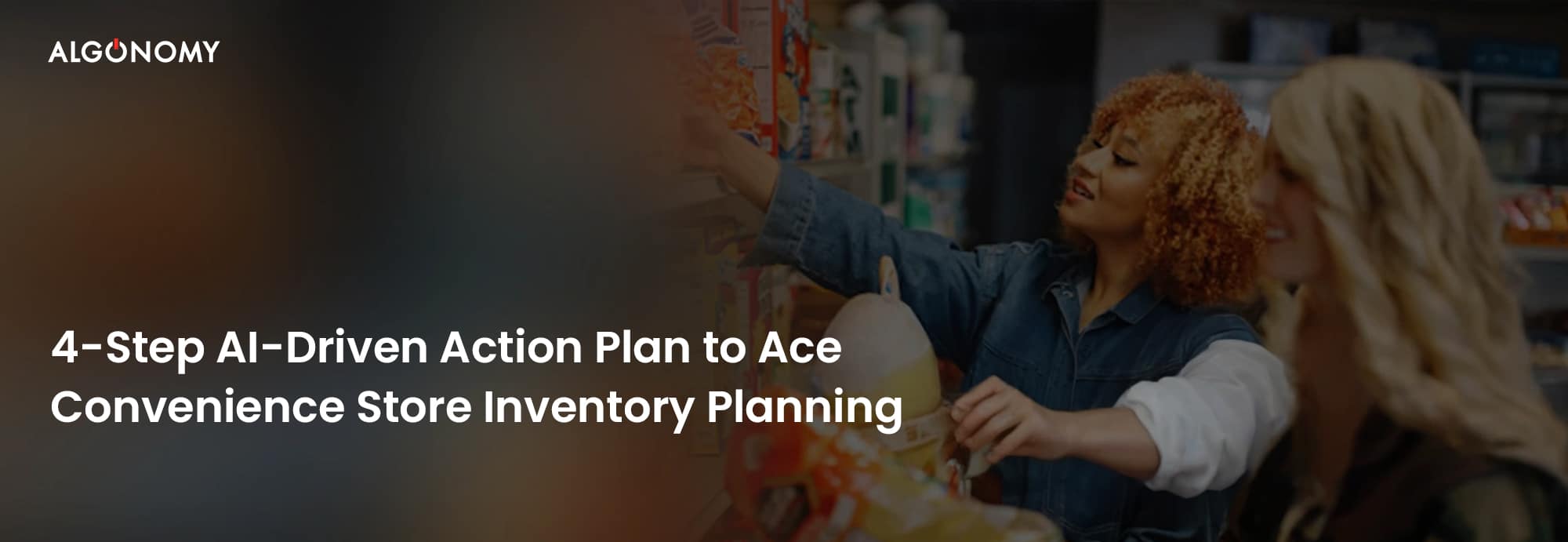Research shows that the global convenience store market size is USD 663.5 billion, and the revenue projections sit at the USD 3.12 trillion mark for 2028. While the numbers paint a decent picture, stock issues, shrinking profits, spoilage, and loss of sales due to manual promotional planning keep on speed-bumping. Further, 42% of customers point out having the right stock and variety (28%) as the two most important factors for a positive C-store shopping experience.
Ensuring high shelf availability, quick and efficient adaptation to evolving demand patterns, and real-time views over demand shifts and lifts during promotions and discounts can transform inventory planning and boost customer satisfaction. However, these capabilities stem from a robust, intelligent, and self-learning technological infrastructure. But then again, where does one start, and what are the top automation use cases for convenience store inventory planning?
Let’s take a quick look at the answers.
#1 – Start With Demand Forecasting Solution
A whopping $163 billion of inventory is tossed annually due to damage and oversupply. Overstock and out-of-stock are two major cost bleeds for retailers, especially in the convenience store segment, where fresh and ultra-fresh inventory is vulnerable to quick wastage and spoilage. Augmenting demand planning frameworks with advanced AI-driven capabilities can overcome stock issues and help retailers unlock significant inventory cost savings.
While inaccurate demand forecasting can inflate inventory holding costs by up to 30% and erode profit margins, AI-powered forecasting can reduce supply chain errors by up to 50%, reduce lost sales by 65%, and reduce warehousing costs by up to 40%. Another critical benefit of accurate demand forecasting is data-driven inventory planning that ensures optimal replenishment at all times while boosting shelf-availability and reducing stock issues.
#2 – Automate Replenishment
Traditionally, demand planners have been working with sheets-based planning systems with basic automation capabilities patched together that result in a fragmented functioning of disparate components. Further, studies reveal that 40% of retailers cancel at least one in ten orders due to inaccurate inventory data.
They are manually cranking the orders up or down on the basis of random adjustments to demand influencers like seasonality, obsolescence, previous quarters’ or previous holidays’ patterns. This can lead to markdowns and wastage while bloating the inventory costs owing to the lack of clarity and visibility over location/product/supply-specific nuances.
Machine Learning-based retail replenishment algorithms are self-learning, adaptive, and exhaustive and can dynamically adjust to changes in demand patterns, external and internal sales influencers, promotions, supply-side disruptions, and more. Intelligent replenishment optimization solutions integrate data across all functions to draw actionable insights for accurate and responsive inventory planning aligned with real-time customer demand. They automatically choose and prioritize the most crucial sales influencers while taking any specific events, such as promotions, in consideration to adjust inventory to demand shifts and lifts.
#3 – Take Data-Driven Inventory Decisions
Nearly 60% of retailers have less than 80% inventory accuracy and face data challenges.
Inaccurate inventory data or siloed data collected in disparately working components of the merchandising ecosystem prevent retailers from placing the right amount of inventory in the right place in a timely manner. This can prove fatal for profitability, especially in the C-Store segment, where managing sales events is already challenging owing to a poor understanding of SKU-level dynamics at specific store locations.
Intelligent inventory replenishment solutions optimize inventory at a product-store level for precision at the hyperlocal level based on granular visibility over demand patterns exhaustive understanding of sales influencers. Retailers can automatically generate highly optimal order plans for inventory at specific store locations, curbing in-store cannibalization, overcoming data challenges, and outsmarting supply chain disruptions.
#4 – Automate Supplier Management
While 45% of global supply chains are expected to be autonomous by 2035, 45% of businesses report limited supply chain visibility, and only 15% of CPOs report visibility beyond Tier 1 suppliers.
Businesses like convenience stores generally have a wide supplier network, especially for categories such as tobacco, beverages, fresh food, packed foods, drinks, groceries, etc. This often translates into switching among multiple supplier management interfaces and manual management of consignment, order, supplier, claims, and various other forms of data.
Communication gaps, loss of context owing to translation, lack of standardized communication formats and channels, and manual collaboration with individual supplier – all these become roadblocks to effective supplier collaboration. Automating supplier management can work wonders in this regard.
Often termed supply chain automation and supplier automation, AI-driven supplier collaboration solutions nip the root cause of inventory challenges stemming from supply-side issues. Automation-powered supplier management systems streamline the entire query response and resolution process via built-in intelligent workflows that can be customized to the business needs. Establishing electronic data exchange capabilities, digital cataloging, and seamless integration of Purchase Orders (POs) and Goods Received Notes (GRNs) across suppliers, manufacturers, and retailers all improve supply chain responsiveness and accuracy.
Automated Supplier Processes and Effective Collaboration Across Supplier Lifecycle Unlock
 10%
10%Inventory Cost
 75%
75%Out-of-Stock Instances
 10-30%
10-30%Wastage
 99%
99%Shelf Availability
A successful C-store inventory planning strategy is fundamentally built on robust and intelligent automation. Further, retailers need to take decisions based on a consolidated and integrated understanding of the interplay among different sales influencers at specific locations, SKU-level, etc. Hence, investing in standalone solutions for demand forecasting, replenishment processes, or supplier management will no longer make the cut.
Integrating core processes for exhaustive modeling and demand pattern analysis, making data-driven inventory decisions, and streamlining supplier management, convenience stores can effectively address the challenges of stock issues, spoilage, and inefficiencies. Such capabilities can effectively reduce inventory costs, and stock issues, improve shelf availability, and pave the way for profitability that doesn’t come at the cost of customer satisfaction.





